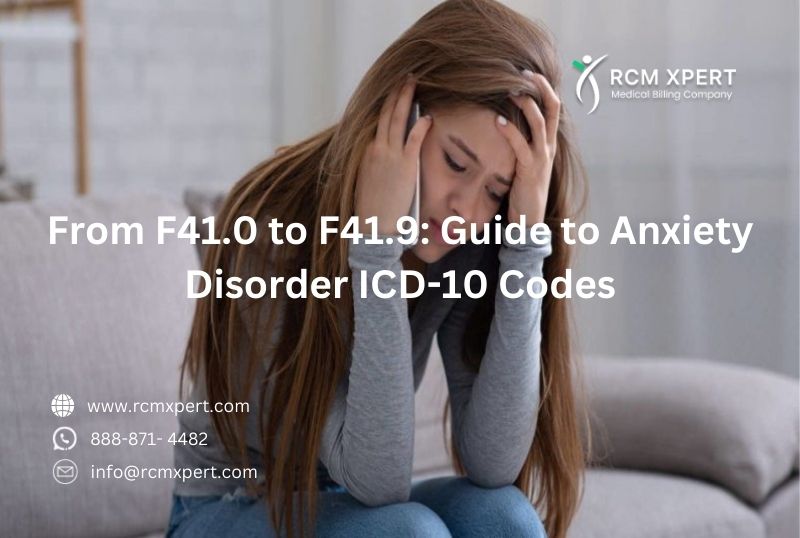Anxiety disorders are among the most common mental health conditions, affecting millions of people worldwide. For healthcare providers, accurately diagnosing and coding these disorders is crucial for proper treatment and insurance reimbursement. This comprehensive guide will walk you through the ICD-10 codes for anxiety disorders, from F41.0 to F41.9, helping you understand their meanings and applications.
What are ICD-10 codes?
Before diving into specific anxiety disorder codes, let’s quickly cover what ICD-10 codes are and why they matter.
ICD-10 stands for the International Classification of Diseases, 10th Revision. It’s a standardized system used globally to classify and code all diagnoses, symptoms, and procedures in healthcare settings. These codes ensure consistent communication between healthcare providers, researchers, and insurance companies.
For mental health conditions like anxiety disorders, ICD-10 codes fall under Chapter V, which covers mental and behavioral disorders. The codes we’ll focus on today, F41.0 to F41.9, are specifically dedicated to anxiety disorders.
Why anxiety disorder ICD-10 codes matter
Understanding and correctly using anxiety disorder ICD-10 codes is important for several reasons:
1. Accurate diagnosis: Proper coding helps healthcare providers pinpoint the specific type of anxiety disorder a patient is experiencing.
2. Treatment planning: Different anxiety disorders may require different treatment approaches, so accurate coding can guide treatment decisions.
3. Insurance reimbursement: Insurance companies rely on ICD-10 codes to process claims and determine coverage.
4. Research and statistics: These codes allow researchers to track the prevalence and patterns of anxiety disorders across populations.
Now, let’s break down each anxiety disorder ICD-10 code from F41.0 to F41.9.
F41.0: Panic disorder [episodic paroxysmal anxiety]
Panic disorder is characterized by recurring, unexpected panic attacks. These attacks involve sudden surges of intense fear or discomfort, often accompanied by physical symptoms like heart palpitations, sweating, and shortness of breath.
Key features of F41.0:
– Recurrent panic attacks
– Persistent worry about future attacks
– Significant changes in behavior due to the attacks
Example: Sarah experiences sudden, intense episodes of fear several times a month, accompanied by chest pain and dizziness. She’s constantly worried about when the next attack might occur and avoids crowded places as a result.
F41.1: Generalized anxiety disorder
Generalized anxiety disorder (GAD) involves persistent and excessive worry about various aspects of life, such as work, school, health, or finances.
Key features of F41.1:
– Excessive anxiety and worry occurring more days than not for at least 6 months
– Difficulty controlling the worry
– Physical symptoms like restlessness, fatigue, and muscle tension
Example: John finds himself constantly worrying about his job performance, family’s health, and financial future. This worry is difficult to control and often leads to trouble sleeping and concentrating at work.
F41.2: Mixed anxiety and depressive disorder
This code is used when symptoms of both anxiety and depression are present, but neither is clearly predominant or severe enough to justify a separate diagnosis.
Key features of F41.2:
– Presence of both anxiety and depressive symptoms
– Neither set of symptoms is severe enough for a standalone diagnosis
– Significant distress or impairment in daily functioning
Example: Lisa experiences persistent low mood and loss of interest in activities, along with excessive worry and restlessness. While these symptoms impact her daily life, they don’t meet the full criteria for either major depressive disorder or a specific anxiety disorder on their own.
F41.3: Other mixed anxiety disorders
This code is used for anxiety disorders that don’t fit neatly into other categories but involve a mix of symptoms from various anxiety disorders.
Key features of F41.3:
– Presence of symptoms from multiple anxiety disorders
– Doesn’t meet full criteria for any single specific anxiety disorder
– Causes significant distress or impairment
Example: Mike experiences some symptoms of social anxiety in certain situations, occasional panic-like episodes, and generalized worry about various life events. While these symptoms impact his life, they don’t fully align with any single anxiety disorder diagnosis.
F41.8: Other specified anxiety disorders
This code is used for anxiety disorders that cause significant distress or impairment but don’t meet the full criteria for other specified anxiety disorders.
Key features of F41.8:
– Presence of anxiety symptoms causing significant problems in daily life
– Doesn’t meet full criteria for other specified anxiety disorders
– Clinician specifies the reason for not meeting other criteria
Example: Emma experiences intense anxiety specifically related to her health, constantly worrying about potential illnesses. While this causes significant distress, it doesn’t fully meet the criteria for hypochondriasis or generalized anxiety disorder.
F41.9: Anxiety disorder, unspecified
This code is used when an anxiety disorder is present, but there isn’t enough information to make a more specific diagnosis, or the symptoms don’t meet the criteria for any specific anxiety disorder.
Key features of F41.9:
– Presence of anxiety symptoms causing distress or impairment
– Insufficient information for a more specific diagnosis
– Often used as a temporary diagnosis while gathering more information
Example: David seeks help for feelings of anxiety that are impacting his daily life, but during the initial assessment, there isn’t enough information to determine which specific type of anxiety disorder he might have.
How to use anxiety disorder ICD-10 codes effectively
To make the most of these ICD-10 codes in your practice or understanding, consider the following tips:
1. Thorough assessment: Conduct comprehensive evaluations to gather all necessary information for accurate coding.
2. Stay updated: Keep informed about any changes or updates to ICD-10 codes.
3. Be specific: Use the most specific code possible based on the patient’s symptoms and presentation.
4. Document carefully: Provide detailed documentation to support your choice of ICD-10 code.
5. Consider comorbidities: Be aware that anxiety disorders often co-occur with other mental health conditions.
The importance of accurate diagnosis and coding
Accurate diagnosis and coding of anxiety disorders using ICD-10 codes is crucial for several reasons:
1. Proper treatment: Different anxiety disorders may respond better to specific treatments. Accurate diagnosis ensures patients receive the most appropriate care.
2. Insurance coverage: Correct coding helps ensure that patients receive the insurance coverage they’re entitled to for their specific condition.
3. Research advancements: Proper coding contributes to more accurate research data, which can lead to better understanding and treatment of anxiety disorders.
4. Patient understanding: Accurate diagnosis can help patients better understand their condition and feel validated in their experiences.
Challenges in coding anxiety disorders
While ICD-10 codes provide a standardized system for classifying anxiety disorders, there can be challenges in their application:
1. Overlapping symptoms: Many anxiety disorders share similar symptoms, making it challenging to differentiate between them.
2. Comorbidity: Anxiety disorders often co-occur with other mental health conditions, complicating diagnosis and coding.
3. Evolving understanding: Our understanding of mental health conditions continually evolves, sometimes outpacing coding systems.
4. Subjective experiences: Anxiety is a highly subjective experience, and patient descriptions may not always neatly fit into predefined categories.
Future directions in anxiety disorder classification
As our understanding of mental health continues to grow, we may see changes in how anxiety disorders are classified and coded. Some potential future directions include:
1. Dimensional approaches: Moving towards a more spectrum-based understanding of anxiety disorders rather than distinct categories.
2. Biomarker integration: Incorporating biological markers into diagnosis and classification of anxiety disorders.
3. Personalized medicine: Developing more individualized approaches to diagnosis and treatment based on a person’s unique symptom profile and biological factors.
4. Digital health integration: Utilizing data from digital health tools and wearables to inform diagnosis and tracking of anxiety disorders.
Conclusion
Understanding ICD-10 codes for anxiety disorders from F41.0 to F41.9 is crucial for healthcare providers, researchers, and anyone involved in mental health care. These codes provide a standardized language for describing and classifying different types of anxiety disorders, facilitating accurate diagnosis, appropriate treatment, and effective communication across the healthcare system.
While the current system has its challenges, it provides a valuable framework for understanding and addressing anxiety disorders. As our knowledge of mental health continues to evolve, we can expect to see further refinements and improvements in how we classify and code these conditions.
Remember, behind every code is a person experiencing real challenges. By using these codes accurately and thoughtfully, we can better serve individuals struggling with anxiety disorders and contribute to improved mental health care for all.














